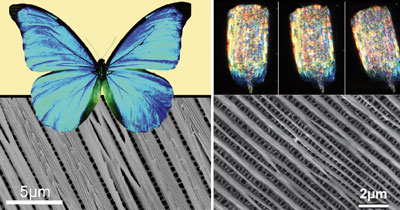
 A collection of review articles on Materials for Sensing and Detection published in Journal of Materials Chemistry and Analyst.
A collection of review articles on Materials for Sensing and Detection published in Journal of Materials Chemistry and Analyst.
Journal of Materials Chemistry publishes research on the high impact applications, properties and synthesis of exciting new materials (more…). Articles in Analyst report high impact research in analytical, bioanalytical and detection science (more…). If you’re working in the area why not submit your next article via the Journal of Materials Chemistry or Analyst homepage?
Highlights
Adaptive DNA-based materials for switching, sensing, and logic devices
Michael J. Campolongo, Jason S. Kahn, Wenlong Cheng, Dayong Yang, Tiffany Gupton-Campolongo and Dan Luo
J. Mater. Chem., 2011, DOI: 10.1039/C0JM03854G Advance Article
Microcapsules as optical biosensors
Mike McShane and Dustin Ritter
J. Mater. Chem., 2010, 20, 8189-8193
Conducting polymernanowires for chemiresistive and FET-based bio/chemical sensors
Carlos M. Hangarter, Mangesh Bangar, Ashok Mulchandani and Nosang V. Myung
J. Mater. Chem., 2010, 20, 3131-3140
Minireviews
Biologically modified hydrogels for chemical and biochemical analysis
Sean P. Bird and Lane A. Baker
Analyst, 2011, Advance Article
Recent advances in fluorescent and colorimetric conjugated polymer-based biosensors
Kangwon Lee, Laura K. Povlich and Jinsang Kim
Analyst, 2010, 135, 2179-2189
Single molecule sensing by nanopores and nanopore devices
Li-Qun Gu and Ji Wook Shim
Analyst, 2010, 135, 441-451
Feature Articles
Mechanochromic systems for the detection of stress, strain and deformation in polymeric materials
David R. T. Robert and Simon J. Holder
J. Mater. Chem., 2011, DOI: 10.1039/C0JM04237D Advance Article
Nanoparticleassemblies for biological and chemical sensing
Shaoqin Liu and Zhiyong Tang
J. Mater. Chem., 2010, 20, 24-35
Critical Reviews
Nanoparticle-based strategies for detection and remediation of environmental pollutants
Yanyan Liu, Gaoxing Su, Bin Zhang, Guibin Jiang and Bing Yan
Analyst, 2011, 136, 872-877
Nanomaterial surface chemistry design for advancements in capillary electrophoresis modes
Michael R. Ivanov and Amanda J. Haes
Analyst, 2011, 136, 54-63
Diatoms: Self assembled silica nanostructures, and templates for bio/chemical sensors and biomimetic membranes
Wenrong Yang, Pascal J. Lopez and Gary Rosengarten
Analyst, 2011, 136, 42-53
Graphene versus carbon nanotubes for chemical sensor and fuel cell applications
Douglas R. Kauffman and Alexander Star
Analyst, 2010, 135, 2790-2797
Applications
Bio-imaging, detection and analysis by using nanostructures as SERS substrates
Wei Xie, Penghe Qiu and Chuanbin Mao
J. Mater. Chem., 2011, DOI: 10.1039/C0JM03301D Advance Article
If you’re interested in reading more articles in this area, why not read the Journal of Materials Chemistry and Analyst joint web theme on Materials for Detection or the Journal of Materials Chemistry themed issue on Inorganic nanoparticles for biological sensing, imaging and therapeutics.

















 A collection of review articles on Materials for Sensing and Detection published in Journal of Materials Chemistry and Analyst.
A collection of review articles on Materials for Sensing and Detection published in Journal of Materials Chemistry and Analyst.


 Benefits of N for O substitution in polyoxoanionic electrode materials: a first principles investigation of the electrochemical properties of Li2FeSiO4−yNy (y = 0, 0.5, 1)
Benefits of N for O substitution in polyoxoanionic electrode materials: a first principles investigation of the electrochemical properties of Li2FeSiO4−yNy (y = 0, 0.5, 1)

 The influence on Fermi energy of Li-site change in LizTi1−yNiyS2 on crossing z = 1
The influence on Fermi energy of Li-site change in LizTi1−yNiyS2 on crossing z = 1
